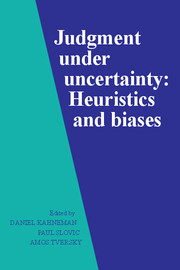Book contents
- Frontmatter
- Contents
- List of contributors
- Preface
- Part I Introduction
- Part II Representativeness
- Part III Causality and attribution
- 7 Popular induction: Information is not necessarily informative
- 8 Causal schemas in judgments under uncertainty
- 9 Shortcomings in the attribution process: On the origins and maintenance of erroneous social assessments
- 10 Evidential impact of base rates
- Part IV Availability
- Part V Covariation and control
- Part VI Overconfidence
- Part VII Multistage evaluation
- Part VIII Corrective procedures
- Part IX Risk perception
- Part X Postscript
- References
- Index
10 - Evidential impact of base rates
Published online by Cambridge University Press: 05 May 2013
- Frontmatter
- Contents
- List of contributors
- Preface
- Part I Introduction
- Part II Representativeness
- Part III Causality and attribution
- 7 Popular induction: Information is not necessarily informative
- 8 Causal schemas in judgments under uncertainty
- 9 Shortcomings in the attribution process: On the origins and maintenance of erroneous social assessments
- 10 Evidential impact of base rates
- Part IV Availability
- Part V Covariation and control
- Part VI Overconfidence
- Part VII Multistage evaluation
- Part VIII Corrective procedures
- Part IX Risk perception
- Part X Postscript
- References
- Index
Summary
In many contexts people are required to assess the probability of some target event (e.g., the diagnosis of a patient or the sales of a textbook) on the basis of (a) the base-rate frequency of the target outcome in some relevant reference population (e.g., the frequency of different diagnoses or the distribution of textbook sales), (b) some specific evidence about the case at hand (e.g., the patient's response to a diagnostic test or the table of contents of the text in question).
Concern with the role of base-rate data in intuitive predictions about individual cases was expressed by Meehl & Rosen (1955), who argued, using Bayes' rule, that predictions of rare outcome (e.g., suicide) on the basis of fallible data is a major source of error in clinical prediction. Meehl & Rosen did not conduct experimental studies but they cited examples from the literature on clinical diagnosis, in which base-rate information was not taken into account.
To obtain an experimental test of the impact of base-rate data, we presented subjects with a description of a graduate student, or a professional, and asked them to predict his field of study or his profession, respectively (Kahneman & Tversky, 1973, 4). These studies showed that posterior probability judgments were determined primarily by the degree to which the description was similar to or representative of the respective professional stereotype (e.g., of librarians or lawyers).
- Type
- Chapter
- Information
- Judgment under UncertaintyHeuristics and Biases, pp. 153 - 160Publisher: Cambridge University PressPrint publication year: 1982
- 220
- Cited by



